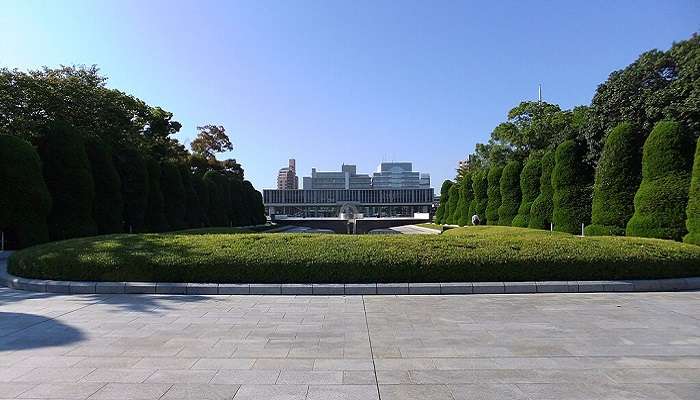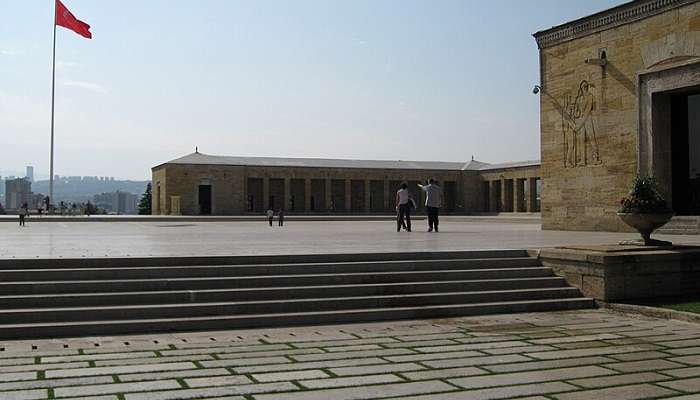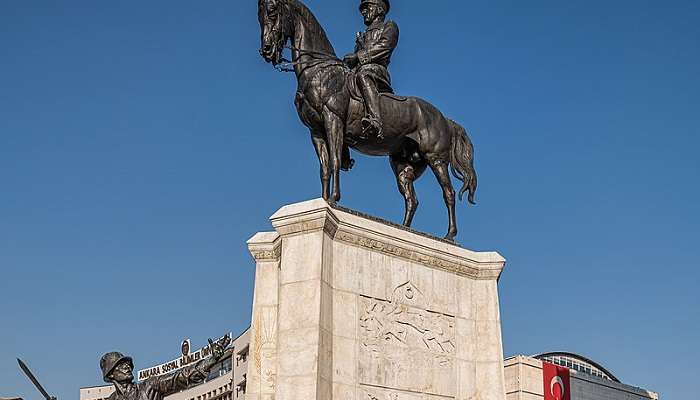Your Complete Guide To The Architectural Marvel Of Anıtkabir In Turkey

Anıtkabir is in the Çankaya district of Ankara and is a symbol of pride and history of the country. Anıtkabir is more than a mausoleum because it is the tomb of Mustafa Kemal Atatürk, the founder of the Turkish Republic and a symbol of modern Turkey. The grand architecture is of course influenced by different historical styles and it is clear that the nation has a great respect for its leader. Tourists from all over the globe come to Ataturk’s Mausoleum to mourn, to be impressed by the atmosphere of the place and to appreciate the details of the architecture and the meaning of the ornaments.
History Of Anıtkabir

It’s the story of the great leader who founded modern Turkey, Mustafa Kemal Atatürk. He died on November 10, 1938 and his ashes were first buried in the Ethnography Museum of Ankara before the construction of Anıtkabir. In 1941 the government launched an international competition for the design of the new building which was won by Emin Onat and Orhan Arda, two Turkish architects. Construction started in 1944 in Rasattepe which is now Anıttepe and the construction was completed in 1953. Anıtkabir is not only Atatürk’s tomb but also the monument of the change that he brought to Turkey and the country he envisioned and built. It represents modern Turkey, a forward looking nation going into the 22nd century.
Also Read: Butterfly Valley In Turkey
Architecture Of Anıtkabir

The architecture of Anıtkabir is neoclassical in style with Seljuk, Ottoman and Hittite influences. The mausoleum is the main attraction with its grand Hall of Honor which is home to a 40-ton white marble sarcophagus which is symbolic. The façade of the building is decorated with fine reliefs and inscriptions; the use of travertine and marble from different parts of Turkey also contributes to the majesty of the building. The architectural design of the structure is very serious and reverential towards Atatürk and therefore is a symbol of Turkish nationalism. The site of the building mesmerises anyone who stands before it as it also gives you a hint of its classical Greek inspirations.
Design And Layout Of Anıtkabir
Anıtkabir, the mausoleum of Mustafa Kemal Atatürk in Ankara, features a grand layout with ceremonial courtyards, a monumental hall, and landscaped gardens, symbolising Turkey’s national pride and heritage.
1. The Hall Of Honor

The Hall of Honor is considered to be the sacred part of Anıtkabir as it contains the tomb of Mustafa Kemal Atatürk. The hall is quite simple and at the same time very large, with a high stuccoed ceiling and marble floor. The sarcophagus is of red marble which signifies the blood that was spilt during the War of Independence. On the walls of the hall, there are quotations from Atatürk’s speeches which express his idea of Turkey. A skylight is provided above to let in natural light and this gives a rather sombre look to the sarcophagus. This sacred space reflects the admiration and the reverence that is accorded to Atatürk.
Timings: 9:00 AM to 5:00 PM
Entry Fee: None
Related Post: Places To Visit In Turkey With Family
2. The Peace Park

Anıtkabir is surrounded by the Peace Park which is the reflection of Atatürk’s principle of ‘Peace at Home, Peace in the World’. The park occupies an area of over 750,000 square metres and is filled with trees and plants from different parts of the world in support of peace. More than 104 species of plants from different countries were planted here, and this symbolised that the world can be peaceful. The architecture of the park also supports the notion of reflection and contemplation and gives the visitors a chance to think about Atatürk’s work. The Peace Park also has the significance of reminding people the importance of peace in the internal and external politics.
Timings: Open from 8:00 AM to 7:00 PM
Entry Fee: Free
3. The Lion Road

The Lion Road is the magnificent entrance to Anıtkabir with 24 stone lions representing power on both sides of the road. All the lions are sculptured in the Hittite style and symbolise the ancient history of Anatolia as well as protect the tomb of Atatürk. It is 262 metres long and paved with travertine stones that are not even so that people will not be able to walk fast and thus contemplate the importance of the path. The Lion Road leads to the Ceremonial Plaza and provides a grand approach to the mausoleum. This path also supports the respect and dignity that is related to Anıtkabir.
Timings: 9:00 AM to 5:00 PM
Entry Fee: None
Related Post: Turkey In November
4. The Ceremonial Plaza

The Ceremonial Plaza is an open area with dimensions of 129 metres by 84 metres and it can hold up to 15,000 people. It is used for official functions and celebrations including the national holidays like the Republic Day and Atatürk Memorial Day. The two galleries are colonnaded and are adorned with reliefs of historical events of Turkey ranging from the War of Independence to the establishment of the Republic. The floor of the plaza is made of marble with geometric designs that add to the beauty of the plaza. The Ceremonial Plaza is an embodiment of pride and unity of the nation.
Timings: 9:00 AM to 5:00 PM
Entry Fee: None
5. The Atatürk And War Of Independence Museum

The Atatürk and War of Independence Museum is situated under the Hall of Honor and presents Atatürk’s biography and the Turkish War of Independence. The museum is divided into four parts where each part covers different aspects of Atatürk’s life. Some of the displayed items are personal effects, photographs, documents, and miniature scenes of some of the major battles. Among the exhibits, there is Atatürk’s library which is devoted to his intellectual activity. The museum also has a wax statue of Atatürk at his study which gives a realistic look of the leader. This museum is an informative place where one can get acquainted with the changes Atatürk brought to the country.
Timings: 9:00 AM to 5:00 PM
Entry Fee: None
Related Post: Turkey With Kids
Towers Of Anıtkabir Turkey
The Towers of Anıtkabir are striking architectural features that frame the grand mausoleum of Mustafa Kemal Atatürk. These imposing towers stand as symbols of strength and national pride, enhancing the monument’s majestic presence in Ankara.
1. Independence Tower

The Independence Tower has a relief of a young man holding a sword and an eagle by his side which symbolises power and freedom. This tower symbolises the Turkish nation’s desire to remain free, which is one of the main ideas of Atatürk about the country. The statue group of women in the traditional clothes presented in the company’s advertisement represents the dignity, endurance and even the sorrow of Turkish women in the difficult conditions.
2. Freedom Tower

The Freedom Tower has a relief of an angel holding the Turkish Declaration of Freedom and a rearing horse which symbolises the sacredness and the dynamism of freedom. In front of the tower there is a statue group symbolising the Turkish soldier, youth and peasant as the unity and determination of the Turkish people under Atatürk’s leadership.
Related Post: Temples In Turkey
3. Mehmetçik Tower

The Mehmetçik Tower is dedicated to the Turkish foot soldier or Mehmetçik with a sculpture of a mother saying goodbye to her son who is going to war. This picture reflects the bitter-sweet feeling of the Turkish people during the fight for independence of the country. The tower also contains a bookstore and gift shop for the people who visit the place.
4. Victory Tower

The Victory Tower is dedicated to the main victories of the Turkish War of Independence and has inscriptions of Atatürk’s sayings and dates of the main battles. Within the tower there is the carriage on which Atatürk’s coffin was placed during the funeral and it symbolises the struggle for independence and Atatürk’s heritage.
Related Post: Hot Springs In Turkey
5. Peace Tower

The Peace Tower also embodies Atatürk’s principle of ‘peace at home, peace in the world’ as there is a carving of a soldier shielding non-combatants. This imagery represents the Turkish Army as the guardian of the nation and the one that ensures that the country prospers in the safe environment provided by the military.
You May Also Like To Read: Kastamonu In Turkey
Anıtkabir is a symbol of the great leader Mustafa Kemal Atatürk and his deeds for the country. The architecture, symbolism and history of the site make it a very important site for anyone who wants to learn about Turkish culture. Visiting Anıtkabir provides a great insight into Atatürk’s vision and the principles that he bequeathed to the Turkish Republic. Take a trip to Turkey today and be inspired by the architectural design of Anıtkabir.
For our editorial codes of conduct and copyright disclaimer, please click here.
Cover Image Credit : William Neuheisel for Wikipedia
Frequently Asked Questions About Anıtkabir
What is the meaning of lions on Road of Lions?
The lions on the Road of Lions represent the 24 Oghuz Turkic Tribes which signify power, solidarity and harmony.
Are the visitors allowed to access the Hall of Honor?
People can pay their respect to Atatürk by visiting the Hall of Honor where there is an emblematic tomb of Atatürk; however, the real tomb of Atatürk is situated on the lower level.
What is Atatürk Mausoleum dress code?
There is no specified Atatürk Mausoleum dress code, but it is advised to dress respectfully covering shoulders and knees.
What is Anitkabir entrance fee?
Anitkabir entrance fee is zero and tourists can explore this famous monument free of charge from morning 9 AM to evening 5 PM.
When is the best time to visit Anıtkabir?
The best time to visit Anıtkabir is in the morning or in the evening because it is not crowded and the environment is calm.
People Also Read:
Bara Imambara Itmad- ud- Daula Gol Gumbaz

With a passion for exploring and travelling to the roads long forgotten, experience the world through enthralling stories and adventures. Join me as I share my experiences at some of the world’s most popular tourist destinations and quench that pestering curiosity with something exciting!











